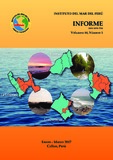Por favor, use este identificador para citar o enlazar este ítem:
https://hdl.handle.net/20.500.12958/3155| Título : | Monitoreo de bancos naturales de invertebrados marinos comerciales. Región Tumbes, Perú. Octubre 2014 |
| Otros títulos : | Monitoring of natural banks of commercial marine invertebrates. Tumbes Region, Peru. October 2014. |
| Autor : | Alemán Mejía, Solange Alexander Montero Rodríguez, Percy Vera, Manuel Luque Sánchez, Carlos Ordinola Zapata, Elmer |
| Palabras clave : | Donax Dentifer;Crassostrea Iridescens;Bancos Naturales;Invertebrados;Tumbes - Perú |
| Fecha de publicación : | 2017 |
| Editorial : | Callao |
| Citación : | Inf Inst Mar Perú 44(1), 2017. p. 43-55 |
| Citación : | Informe IMARPE;vol. 44 n°1, 2017 |
| Resumen : | En octubre 2014, se monitorearon los bancos naturales, de palabritas (Donax dentifer) en el intermareal arenoso y, ostra (Crassostrea iridescens) en el submareal rocoso del litoral de la Región Tumbes. En el intermareal se evaluaron seis estaciones, realizando transectos perpendiculares a la costa con dos réplicas separadas cada 10 m y, en el submareal, fueron 40 estaciones con dos réplicas separadas cada 10 m. La densidad media de palabritas fue 78,1 ind.m-2 y de ostra 2,5 ind.m-2. La estructura de tallas en palabritas fue bimodal, talla media en 24,1 mm LV, la de ostra fue polimodal, talla media en 84,5 mm AV. En ambas especies se registró elevada presencia de ejemplares jóvenes. En el intermareal, los promedios de temperatura disminuyeron con la latitud, y los de oxígeno disuelto (OD) aumentaron. En el submareal la batimetría no presentó diferencias consistentes; las condiciones hídricas mostraron corrientes superficiales (CS) con predominio de dirección sur-suroeste (SSW) y velocidades menores. Se evidenciaron condiciones de homogenización por corrientes verticales en la columna de agua, la que tuvo características de ATS (S<34 ups), originando distribución y condiciones similares en superficie y fondo en cuanto a temperatura, pH, OD, salinidad y nutrientes. ABSTRACT: In October 2014, the natural banks of the bean clam (Donax dentifer) in the sandy intertidal zone and oyster (Crassostrea iridescens) in the rocky subtidal zone in the Region of Tumbes were monitored. In the intertidal, six stations were evaluated, performing transects perpendicular to the coast with two replicates separated every 10 m, and in the subtidal there were 40 stations with two replicates separated every 10 m. The mean density of the bean clam was 78.1 ind.m-2 and 2.5 ind.m-2 oyster. The size structure in the bean clam was bimodal, mean size in 24.1 mm VL, the oyster was polymodal, mean size in 84.5 mm VW. In both species there was a high presence of young specimens. In the intertidal, the temperature average decreased with the latitude, and the dissolved oxygen (OD) increased. In the subtidal the bathymetry did not present consistent differences; water conditions showed surface currents (SC) predominantly south-southwest (SSW) and lower velocities. Homogenizing conditions were evidenced by vertical currents in the water column, which had characteristics TSA (S<34 psu), causing distribution and similar conditions in surface and bottom in terms of temperature, pH, DO, salinity and nutrients. |
| Descripción : | Informe IMARPE 44(1), 2017 p. 43-55 |
| URI : | https://hdl.handle.net/20.500.12958/3155 |
| Aparece en las colecciones: | Informe vol. 44(1), 2017 |
Ficheros en este ítem:
| Fichero | Descripción | Tamaño | Formato | |
|---|---|---|---|---|
| Informe 44(1)-8.pdf | 3,86 MB | Adobe PDF |  Visualizar/Abrir |
Este ítem está sujeto a una licencia Creative Commons Licencia Creative Commons

